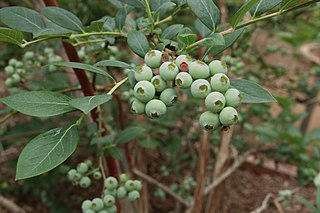Lowbush berry may refer to:
- Lowbush blueberry
- Wild lowbush blueberry, Vaccinium angustifolium
- Lowbush cranberry, a common name for several flowering plants
Lowbush berry may refer to:

A berry is a small, pulpy, and often edible fruit. Typically, berries are juicy, rounded, brightly colored, sweet, sour or tart, and do not have a stone or pit, although many pips or seeds may be present. Common examples are strawberries, raspberries, blueberries, blackberries, red currants, white currants and blackcurrants. In Britain, soft fruit is a horticultural term for such fruits.

Vaccinium is a common and widespread genus of shrubs or dwarf shrubs in the heath family (Ericaceae). The fruits of many species are eaten by humans and some are of commercial importance, including the cranberry, blueberry, bilberry (whortleberry), lingonberry (cowberry), and huckleberry. Like many other ericaceous plants, they are generally restricted to acidic soils.
Honeyberry or honey berry is a common name for the edible fruits of several plants and may refer to:

The Atlantic coastal pine barrens is a now rare temperate coniferous forest ecoregion of the Northeast United States distinguished by unique species and topographical features, generally nutrient-poor, often acidic soils and a pine tree distribution once naturally controlled by frequent fires.

Vaccinium angustifolium, commonly known as the wild lowbush blueberry, is a species of blueberry native to eastern and central Canada and the northeastern United States, growing as far south as the Great Smoky Mountains and west to the Great Lakes region.

Vaccinium myrtilloides is a shrub with common names including common blueberry, velvetleaf huckleberry, velvetleaf blueberry, Canadian blueberry, and sourtop blueberry. It is common in much of North America, reported from all 10 Canadian provinces plus Nunavut and Northwest Territories, as well as from the northeastern and Great Lakes states in the United States. It is also known to occur in Montana and Washington.

Vaccinium darrowii, with the common names Darrow's blueberry, evergreen blueberry, scrub blueberry, or southern highbush blueberry, is a species of Vaccinium in the blueberry group.

Blueberry pie is a pie with a blueberry filling. Blueberry pie is considered one of the easiest pies to make because it does not require pitting or peeling of fruit. It usually has a top and bottom crust. The top crust can be a circular crust but the pie can also have a crumble crust or no top crust at all. Blueberry pies are often eaten in the summertime because that is when blueberries are in season.
Inkberry is a common name for several unrelated plants:

A number of plants in the genus Vaccinium share the common name Evergreen blueberry:

Blueberries are perennial flowering plants with blue or purple berries. They are classified in the section Cyanococcus within the genus Vaccinium. Vaccinium also includes cranberries, bilberries, huckleberries and Madeira blueberries. Commercial blueberries—both wild (lowbush) and cultivated (highbush)—are all native to North America. The highbush varieties were introduced into Europe during the 1930s.
Lowbush cranberry is a common name for several flowering plants and may refer to:

Vaccinium pallidum is a species of flowering plant in the heath family known by the common names hillside blueberry, Blue Ridge blueberry, late lowbush blueberry, and early lowbush blueberry. It is native to central Canada (Ontario) and the central and eastern United States plus the Ozarks of Missouri, Arkansas, southeastern Kansas and eastern Oklahoma.

Blueberry shoestring virus (BBSSV) is a disease-causing virus that is commonly transmitted by the aphid vector, Illinoia pepperi. The blueberry shoestring virus disease is very prominent in highbush and lowbush blueberry plants in the northeastern and upper Midwest of the United States. Symptoms can vary significantly depending on the environment, but the most common disease symptoms are reddish streaking on young stems, reduced vigor and strap-shaped leaves. The blueberry shoestring virus disease can be managed by eliminating the aphid vector through the use of biological, chemical or cultural controls. In severe cases, the disease leads to an extensive loss of yield and marketable fruit.
Vaccinium boreale, common name northern blueberry, sweet hurts or bleuet boréal, is a plant species native to the northeastern United States and eastern Canada. It has been reported from Québec, New Brunswick, Nova Scotia, Newfoundland & Labrador, Maine, New Hampshire, Vermont, and New York State. It grows in tundra, rocky uplands and in open conifer forests at elevations up to 2,000 metres (6,600 ft).
The Blueberry leaf mottle virus (BLMV) is a Nepovirus that was first discovered in Michigan in 1977. It has also appeared in New York, eastern Canada, Bulgaria, Hungary, and Portugal.
Southern blueberry is a common name for several plants native to the southeastern United States and may refer to:

Colletes validus, colloquially known as the blueberry cellophane bee or blueberry polyester bee, is a solitary, specialist bee in the family Colletidae. It is found primarily in eastern North America where it nests in sandy soils near ericaceous plants.
Highbush is an adjective for various types of berries: